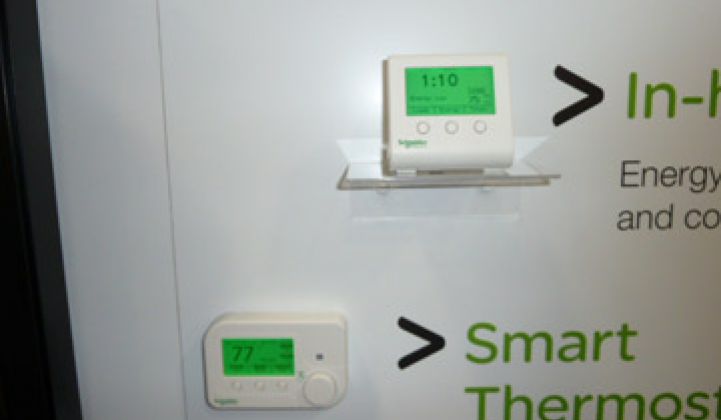San Diego, Calif. -- Who foots the bill?
That’s the big question when it comes to home networking and automation here at DistribuTECH, which is taking place this week in San Diego. A home automation system costs between $300 and $600, not including the $250 smart meter. Consumers aren’t willing to pay for that, many believe, considering that the main beneficiaries are utilities seeking to avoid peak power moments. Utilities and demand response providers, meanwhile, would like to pay part of the cost through rate increases.
So some of the leading ideas are:
--Rely on behavioral programs. Opower, which encourages consumes to conserve through notes and behavioral psychology, says that it can drop home power consumption by 2 percent to 3 percent and has set a goal of boosting that number to five percent.
“This is how 90 percent of us will experience the smart grid,” said Ogi Kavazovic, senior director of marketing and strategy. “The 2 percent to 3 percent is without smart meters.”
In its first year of a trial with 35,000 consumers in Sacramento, consumers cut consumption on average by 2.1 percent in the first year and 2.8 percent in the second year. Third-year results are coming soon, but some consumers are topping 3 percent.
In a trial with consumers in Colorado, some consumers are cutting consumption over 4 percent during the summer. Getting to five percent will require matching Opower’s decision engine (which determines if consumers are laggards or not) better with smart meter data.
The cost of Opower’s program comes to around 3 to 4 cents per kilowatt hour. Pricing depends on geography. In California, power generation costs 9 cents a kilowatt-hour, so utilities are willing to spend 6 to 7 cents for efficiency programs, he said. In Pennsylvania, you need to be closer to 4 cents.
Opower currently serves 50 utilities. The goal is to increase that by 100 in 2011. It will also shift from sending monthly reports to more periodic updates.
--Prepaid electricity. Prepaid programs in some jurisdictions have cut bills by 8 percent, according to David Green, executive vice president, customers and markets, of Elster Solutions. That’s not an average, but a case example of what has been achieved. The prepaid programs have to be linked to communications to be effective.
“Even regulatory boards are more open to the idea. It used to be seen as a hammer in low-income housing. ‘Boom. You’re off,” he said. “There is a lot of interest in the Caribbean and Latin America.”
Like Opower, Elster sees the key to success in psychology and communications. Let’s say a consumer pays $100 for a month of power. If they hit the $50 mark ten days in, a text message can be sent. When they hit $75, the light meter can glow yellow, then orange and then red as spending increases.
The Salt River Project in Arizona has one of the largest, and most successful, prepaid programs in the country.
Another idea from Green: leverage public W-iFi networks like those set up for Tropos for some metering communications.
--Time-of-use pricing. While nearly everyone holds out hope for time-of-use pricing plans, only a few utilities have large, extensive TOU programs right now. Moving the needle will require regulatory approval, which can be an 18-month or longer process.
One group will have to be appeased: seniors. Groups like the AARP are already raising concerns and objections, said Green.
--The Asian hotel room key trick. Energy Hub, which is coming out with a new version of its home energy console, argues that both utilities and consumers want a dedicated, easy-to-use device for managing energy. As long as it’s cheap and well designed, it will be palatable. Video soon.
One of the more interesting features of Energy Hub’s system is a row of buttons that lets consumers turn off everything at once. Hit that and the power goes off, sort of like the key card system in Asian hotels: you can’t leave with your keys without turning off the power.
Demand response companies, which already pay consumers $8 to $10 a month to participate in their programs, can foot the bill for a console if consoles are cheap enough, Energy Hub argues.
Side note: Eric Fleming at Energy Hub formerly worked at Segway in the group that studied how to get security personnel to adopt the device. The work went on to indirectly inspire Paul Blart: Mall Cop.
--Get rid of the LCD home monitor. Silver Spring did that last year when it took the box out of Greenbox, the home networking company it bought. Tendril this week said it would eliminate its home unit in most cases. Getting rid of the screen might save $100.



